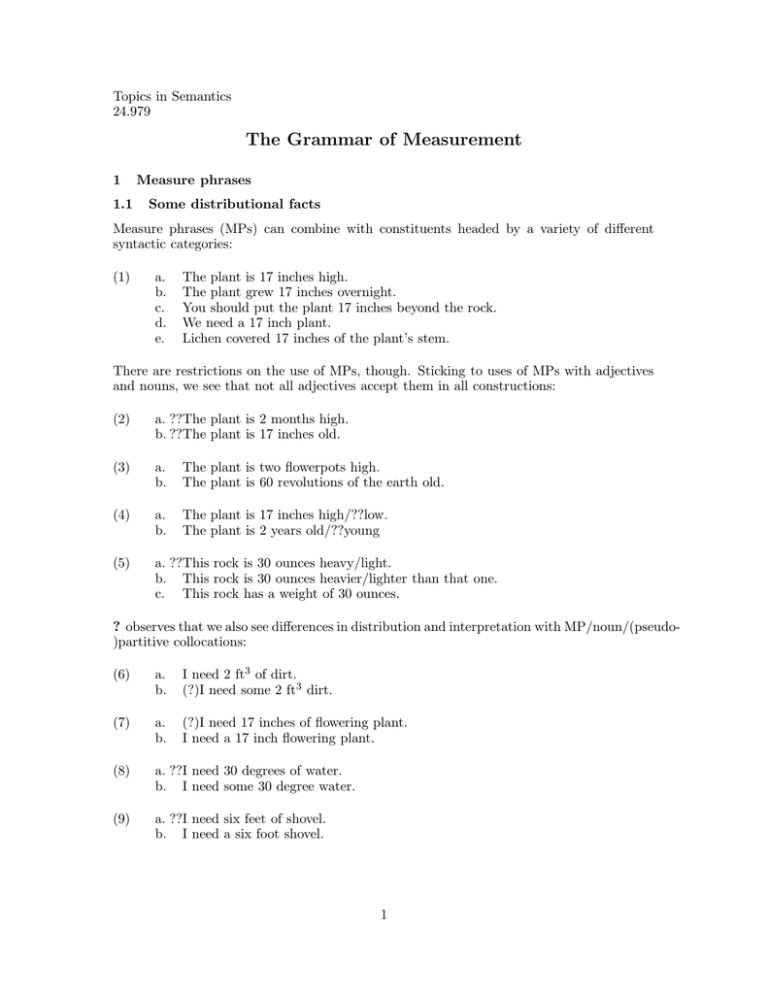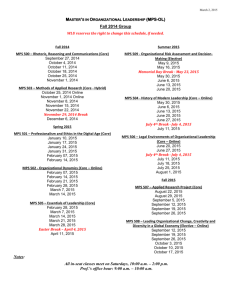The Grammar of Measurement
advertisement

Topics in Semantics
24.979
The Grammar of Measurement
1
1.1
Measure phrases
Some distributional facts
Measure phrases (MPs) can combine with constituents headed by a variety of different
syntactic categories:
(1)
a.
b.
c.
d.
e.
The plant is 17 inches high.
The plant grew 17 inches overnight.
You should put the plant 17 inches beyond the rock.
We need a 17 inch plant.
Lichen covered 17 inches of the plant’s stem.
There are restrictions on the use of MPs, though. Sticking to uses of MPs with adjectives
and nouns, we see that not all adjectives accept them in all constructions:
(2)
a. ??The plant is 2 months high.
b. ??The plant is 17 inches old.
(3)
a.
b.
The plant is two flowerpots high.
The plant is 60 revolutions of the earth old.
(4)
a.
b.
The plant is 17 inches high/??low.
The plant is 2 years old/??young
(5)
a. ??This rock is 30 ounces heavy/light.
b. This rock is 30 ounces heavier/lighter than that one.
c. This rock has a weight of 30 ounces.
? observes that we also see differences in distribution and interpretation with MP/noun/(pseudo­
)partitive collocations:
(6)
a.
b.
I need 2 ft3 of dirt.
(?)I need some 2 ft3 dirt.
(7)
a.
b.
(?)I need 17 inches of flowering plant.
I need a 17 inch flowering plant.
(8)
a. ??I need 30 degrees of water.
b. I need some 30 degree water.
(9)
a. ??I need six feet of shovel.
b. I need a six foot shovel.
1
As we discussed in the very first class, MPs are one of the canonical diagnostics of gradability.
What do these facts tell us about their meaning?
1.2
The semantics of MPs
?: Measure phrases are predicates of scalar intervals (= degrees).
(10)
a.
b.
$2 more expensive, 2 lbs. too heavy, 2 feet away, 2 degrees below zero
that much faster, much too spicy, that much above the house
(11)
a.
b.
Rod A is 2 inches longer than rod B (is).
Rod B is 2 inches shorter than rod A (is).
(12)
a.
b.
c.
d.
length: 0 •——— long(A) ———•———— short(A) −−−−−−−−−−−−−→∞
length: 0 •—— long(B) ——•————— short(B) −−−−−−−−−−−−−−→∞
long(A) − long(B) =
•—-•
short(B) − short(A) =
•—-•
(13)
a.
b.
[[2 inches]](long(A) − long(B)) = 1
[[2 inches]](short(B) − short(A)) = 1
This analysis of measure phrases suggests a meaning along the lines of (14) for the com­
parative morpheme, possibly with existential closure over the difference function when a
differential degree is not expressed:
(14)
[[more]] = λd1 λd2 λf�d,t� .f (d1 − d2 )
This is more or less the way things are done in the Schwarzschild and Wilkenson paper.
A potential explanation for some of the distributional facts: assume that the functions
denoted by measure phrases are defined only for degrees on particular scales, determined
by the head of the MP, and for degrees of particular sorts — closed intervals on a scale (cf.
?).
(15)
[[MP]] = λdd :d is a degree on scale S and d has minimal and maximal values.d
measures MP-much
The first condition will handle cases like ?8 years tall. The second condition will handle
cases like (16b), since negative degrees will typically not satisfy this condition.
(16)
a. The plant is 17 inches high.
b. ??The plant is 17 inches low.
Maybe some positive adjectives do not include the minimal value of the corresponding scale
in their range, even if the scale is a closed one?
(17)
a. ??This rock is 30 ounces heavy/light.
b. This rock is 30 ounces heavier/lighter than that one.
c. This rock has a weight of 30 ounces.
2
In support of the claim that MPs are predicates of scalar intervals, Schwarzschild observes
that the quantifier in a MP must be weak.
(18)
(19)
*most feet taller, *most feet of yarn, *ran most miles, *most inches above the paint­
ing, *weigh most ounces
a.
b.
c.
I regretted every mile farther that I had to walk.
A center makes use of every inch that he is taller than his opponent.
Max weighed every ounce that he expected to weigh after Thanksgiving dinner.
Would this lead us to expect that MPs should always remain inside the scope of other
quantificational expressions?
1.3
Measure phrases and scope
? argues that the ambiguity of the following sort of example demonstrates that comparatives
(qua degree quantifiers) can take scope over at least some other quantificational expressions,
contrary to what is claimed in ?.
context: Student turns in a 10 page paper. The professor says:
(20)
Your paper is required to be exactly 6 pages longer than that.
a. ∀w ∈ Acc : max{d | the paper is d-long} = 10pp + 6pp
b. max{d | ∀w ∈ Acc : the paper is d-long} = 10pp + 6pp
at most 16pp.
at least 16pp.
Or, in terms of the semantics for the comparative above:
a.
b.
∀w ∈ Acc : 6pp(max{d | the paper is d-long} − 10pp)
6pp(max{d | ∀w ∈ Acc : the paper is d-long} − 10pp)
at most 16pp.
at least 16pp.
It is possible to account for this ambiguity without scoping out the comparative, however,
if we allow MPs to scope out.
(21)
[[exactly MP]] = λD�d,t� .max(D) = MP-much
(22)
a.
b.
∀w ∈ Acc : max{d | long(the paper) � 10pp + d} = 6pp
max{d | ∀w ∈ Acc : long(the paper) � 10pp + d} = 6pp
at most 16pp.
at least 16pp.
In fact, we seem to need to allow for this sort of scoping for MPs, considering the fact that
(23) is ambiguous in the same way as the comparatives:
(23)
Your paper is required to be 16 pages long.
a. ∀w ∈ Acc : max{d | long(the paper) � d} = 16pp
b. max{d | ∀w ∈ Acc : long(the paper) � d} = 16pp
at most 16pp.
at least 16pp.
Does thinking in terms of the scope of the MP help us get a handle on the ‘Heim-Kennedy
Generalization’ ?
If this approach to the scope facts works out, and if the ellipsis/scope generalizations Heim
discusses can be handled, then I suspect that the ‘functional’ and ‘relational’ analyses of
3
GAs are going to end up being equivalent in their empirical coverage. Maybe it’s time to
take another look at the syntax of the adjectival projection to try to tease the analyses
apart.... At any rate:
• Analyzing MPs as (containing) predicates on degrees/scalar intervals seems on the
right track, but we do need to allow for them to show scopal behavior.
• Minimally, we can conclude that whenever we have a MP, we have a measure function
as well somewhere in the representation.
2
Measurement inside the nominal projection
2.1
(Pseudo-)partitives and compounds
The constructions under consideration:
(24)
a.
b.
c.
MP of NP
(a) MP NP
MP of DPdef inite
Pseudo-partitive
Compound
Partitive
Schwarzschild claims that MPs are subject to different semantic licensing conditions when
they appear in pseudopartitives and compounds. Specifically:
(25)
a.
MPs in (pseudo-)partitives are acceptable only if they measure a property that
is monotonic with respect to the head.
b. MPs in compounds are acceptable only if they measure a property that is
non-monotonic with respect to the head.
(26)
Monotonicity
A property is monotonic if it tracks part-whole relations.
The following contrasts illustrate these constraints in action. Note that non-monotonicity
may obtain either because the property is non-monotonic for the noun, as in (28), or because
the noun denotation has no part-whole structure (29).
(27)
volume is monotonic wrt dirt
a. I need 2 ft3 of dirt.
b. ??I need 2 ft3 dirt.
(28)
temperature is non-monotonic wrt water
a. ??I need 30 degrees of water.
b. I need some 30 degree water.
(29)
length is non-monotonic wrt (a) shovel
a. ??I need six feet of shovel.
b. I need a six foot shovel.
(30)
weight is non-monotonic wrt (a) baby (sort of)
a. !!She gave birth to 3 kilos of baby.
b. She gave birth to a 3 kilo baby
4
Plurals: like mass nouns, they come with a part-whole structure, so pseudopartitives are
OK and MPs in compounds are necessarily interpreted below plural morphology.
(31)
a.
b.
two kilos of marbles
two kilo marbles
We should never get MPs in count N pseudopartitives, but what about ‘true’ partitives?
(32)
a.
b.
17 inches of ??(the) shovel
2 hours of ??(the) job
This is because the of here, unlike the of in pseudo-partitives, has semantic content: it takes
an entity and returns back a property true of parts of the entity.
(33)
[[ofprt ]] = λxλy.y is a part of x
The difference between partitives and pseudopartitives, then, is that in the former, NP is
enough to give monotonicity, while in the latter it is the of DP constituent that is relevant.
Otherwise, things are exactly the same.
2.2
Schwarzschild’s analysis
RS argues that these semantic constraints are connected to syntactic differences between
MPs in partitives and MPs in compounds:
• the former fall in some specifier of the extended nominal projection
• the latter are in the same position as attributive adjectives
Both of these claims are probably true: in a number of languages, expressions corresponding
to the English compounds are clearly adjectival. He also claims that attributives in general
are non-monontonic, though I didn’t quite follow this argumentation. We’ll come back to
these points shortly.
So the relevant constraints are:
(34)
a.
b.
A MP in a specifier in the extended nominal projection must be monononic.
Attributives must be non-monotonic.
But if MPs can occur in both places, how do we get the difference in monotonicity? Do
they have different meanings in the two types of constructions? Sort of.
Recall that MPs are predicates of degrees, so we need to get a measure function into the
picture somewhere — this is the expression that introduces the property that has to satisfy
monotonicity.
(35)
a.
b.
2 ft3 of dirt
λx.dirt(x) ∧ 2-ft3 (vol(x))
(36)
a.
b.
35 degree water
λx.water(x) ∧ 35-degrees(temp(x))
5
But where does the measure function come from? Three possible answers:
1) it comes from the MP,
2) it comes from a morpheme distinct from both the MP and the nominal, or
3) it comes from the nominal.
RS goes with a versioin of the first answer, whereby a MP is augmented with a measure
function when it is interpreted. This augmentation is context-dependent: in Spec/partitive
position, a MP is augmented according to (37a), and in attributive position, it is augmented
according to (37b).
(37)
a. MON: mp → λP λx.P (x) ∧ mp(µ(x))
condition: µ is monotonic on P
b. NONMON: mp → λP λx.P (x) ∧ mp(µ(x))
condition: µ is not monotonic on P
So at the end of the day, the interpretation of MPs in partitives and compounds is exactly
the same, except for the conditions (presuppositions?) imposed on the measure functions
they incorporate in the two cases.
2.3
Some questions
1. Do we really want to put a measure function inside the meaning of a MP? Or is RS
assuming that we only put it there if we need it? Presumably we don’t need it when it’s
already present:
(38)
a.
b.
Julian is 5 months old.
Julian is 18 months younger than Nicholas.
2. Does the story so far tell us why the (non-)monotonicity constraints hold? I don’t think
so. Presumably this should follow from some difference in the meaning or structure of the
two types of constructions.
2.4
An alternative picture
Two new bits of data to add to the picture. First, examples like those in (39) show that we
can iterate MPs.
(39)
a.
b.
many truckloads of baskets of heads of cabbage
several boxes of reams of sheets of paper
The ‘counter’ always comes at the top:
(40)
a. many truckloads of (*many/three/several) baskets of (*many/three/several)
heads of cabbage
b. several boxes of reams of (*a bit/a lot) of paper
The ‘measure nominals’ obey/give rise to the monotonicity constraints:
(41)
a. many truckloads of 6 bushel baskets of heads of cabbage
b. ??many truckloads of 6 bushels of baskets of heads of cabbage
6
(42)
a. four glasses of water
b. ??16 oz. of glasses of water
c. four 16 oz. glasses of water
d. four large glasses of water
e. four ice-cold glasses of water
f. four glasses of ice-cold water
What all this suggests is that the constituent structure we should be considering is something
more like (43), where U(nit)P can itself be the argument of another UP.
(43)
QP
Q
four
UP
U
glasses
ofP
of
NP
N
water
Second, when we look at compounds, we see that sometimes the MP can come with an
adjective: (44a) and (44b) seem to mean the same thing.
(44)
a.
b.
a six foot shovel
a six foot long shovel
This suggests that MPs in compounds are not adjectives themselves, but rather just the
degree arguments of (possibly implicit) adjectival/measure function heads.
(45)
a.
b.
c.
d.
(46)
a.
a 2 meter (tall) man
a 3 hour (long) class
35 degree (*temperature) water
a 7 lb (*heavy) baby
DP
D
a
b.
DP
NP
DegP
D
N
∅
2 m (tall)
man
NP
DegP
N
35 deg temp
water
Do these reconsiderations of the structures involved here shed any light on why the monotonicity constraints hold? If this picture is right, then there is at least one clear difference
between the two constructions:
• In ‘compounds’, the measure function required by the MP is provided by an adjectival
element.
7
• In partitives, it comes from somewhere else. The fact that the distribution of MPs in
partititives is sensitive to part-whole relations suggests that it should somehow come
from some element of the partitive construction itself!
2.4.1
Partitives
Let’s hypothesize that the of in pseudopartitives to be an occurrence of the same of we get
in partitives: both are looking for arguments that can be subjected to a a part-of relationi
(masses, plurals, collections)?
Let’s also assume that this morpheme doesn’t denote a simple part-of relation, but rather an
n-part of relation. The exact nature of the parts should be underspecified, but crucially
we only get measurements based on parts. That is, the n-part of relation is a kind of
measure function itself.
(47)
a.
b.
[[inch of snow]] = λx.x is a part of snow that measures an inch
ft3 of snow = λx.x is a part of snow that measures a ft 3
On this view, it’s not accidental that we don’t get of with much and many: these expressions
incorporate measure functions themselves! (They’re a kind of gradable adjective; see ?.)
(48)
2.4.2
[[6 inches of snow]] = λP�e,t . | {x | x is a part of snow that measures an inch} ∩
{x | P (x)} |= 6
b. [[6 ft3 of snow]] = λP�e,t . | {x | x is a part of snow that measures a ft 3 } ∩ {x |
P (x)} |= 6
a.
Attributives (= ‘compounds’)
The simplest solution I can think of, which is just to analyze the DegPs in (46) as properties
of individuals (i.e., to give them the same analysis they’d have in predicative position),
certainly doesn’t force monotonicity based on part-whole relations:
(49)
a.
b.
[[[DegP 6 foot tall]]] = λx.tall(x) � 6 feet
[[[DegP 35 deg (temp)]]] = λx.temp(x) � 35 deg
This doesn’t seem to require non-monotonicity either, however. But maybe this is not a
bad thing?
(50)
a.
b.
60 minutes of analysis
a 60 minute (long) analysis
RS’s argument that attributives are not monotonic:
(51)
a. ??(some) 2 ft3 dirt
b. ??(some) 2 liter water
Maybe we can’t combine DegPs with undifferentiated mass terms?
(52)
a. If I melt a heavy, carcinogenic ice cube, I’m likely to get carcinogenic water
but not heavy water.
8
b.
If Jack ate a long, sweet carrot, he’s eaten sweet food but not long food.
I’m not too sure what to make of these examples.
2.5
More data to think about
There is a third form to consider: NP of MP constructions.
(53)
a. 2 liters of oil
b. ??2 liter oil
c. ??oil of 2 liters
(54)
a. ??100 degrees of oil
b. 100 degree oil
c. oil of 100 degrees
d. *exactly 100 degree oil
e. oil of exactly 100 degrees
cf. Spanish, Dutch
And what about cases in which the nominal is a dimesion?!
(55)
a.
b.
c.
6 feet of height
a 6 foot height
a height of 6 feet
(56)
a.
b.
I placed the mirror at *(56a)/(56b)/(56c).
John has (56a)/*(56b)/(56c)
Finally, are ‘inverted’ degree constructions or ‘N of an N’ constructions at all relevant?
(57)
a. I took too big (of) a piece of pie
b. Max wrote so long (of) an introduction to his book that the editor had to
shorten it.
c. How small (of) a car did you buy?
(58)
a. For if you see Toom O’Neill as he is, not as conformity forces us to see, then
there is coming into the room a lovely spring rain of a man. NYTimes Book
Review, 3/11/01
b. This was a three ring circus of a game.
NY Times, 4/15/02
9





